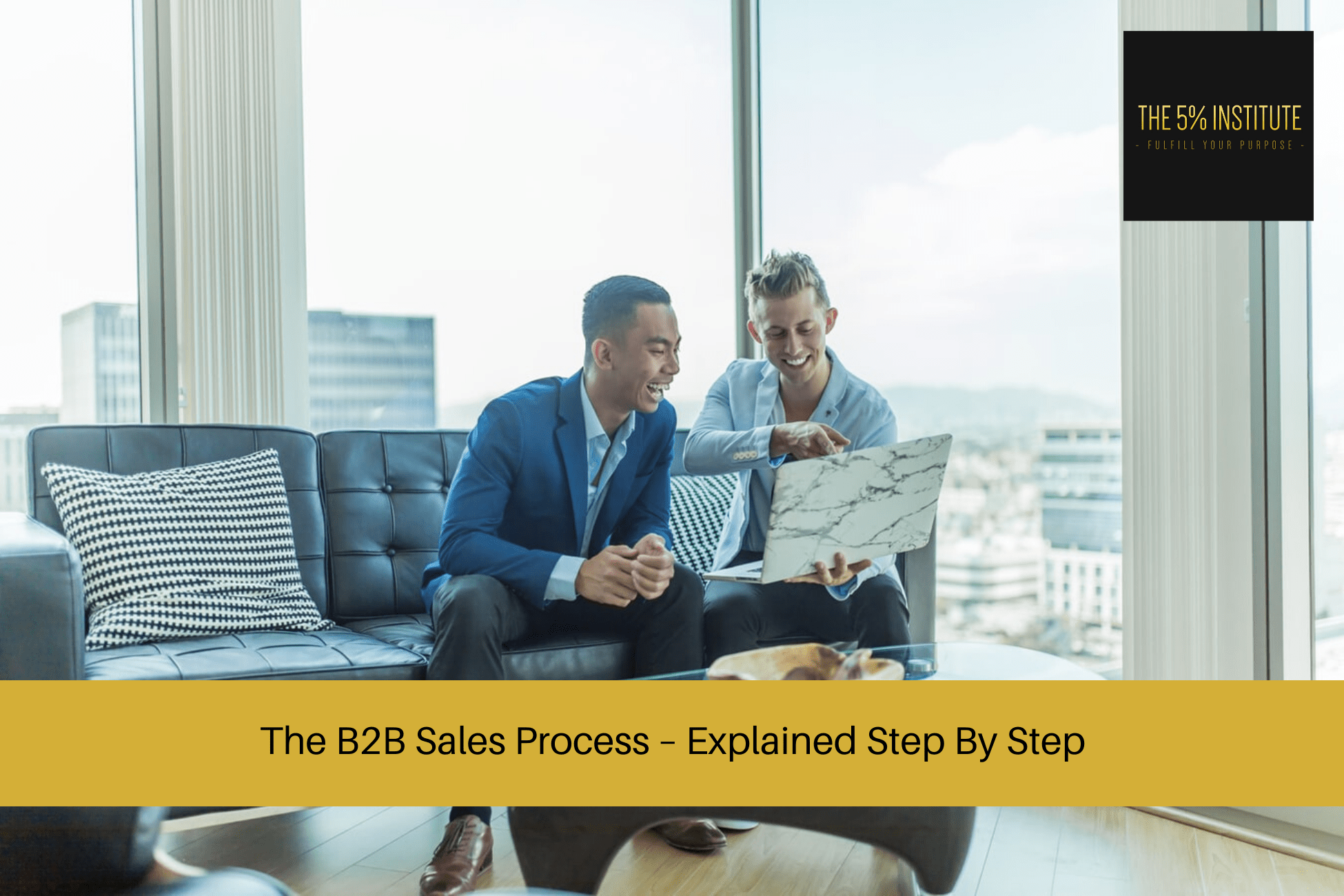
The B2B Sales Process – Explained Step By Step
If you’re selling B2B – also known as business to business; something that’ll be foundational to your success in your industry, is the presence of your B2B sales process.
But what exactly is a B2B sales process?
And what steps should it include?
In this article, you’ll learn what a B2B sales process, as well as all the key ingredients you need to include to ensure your B2B sales process works wonders for you time and time again.
The B2B Sales Process – Explained Step By Step
What Is A B2B Sales Process?
A B2B sales process is a step by step system; or road map you can use, to create consistency with the what in which you prospect, engage potential clients, and close sales.
Many Sales Professionals aren’t formally taught a step by step system to engage with their potential clients, and then enrol them into clients.
This means many Sales Professionals wing it with their sales, which gives them inconsistent results.
A B2B sales process stops you from having all over the place results, because when learnt and implemented correctly, it gives you the clarity and certainty you need to succeed in selling.
Think of it as a system. A system is created to give you consistent results.
By putting into place a B2B sales process, you’ll have a step by step road map to follow and lean on, so you’ll minimise the guesswork and know exactly what to do and say during each step of the sales process.
The Benefits Of Using A B2B Sales Process
Following a B2B sales process will give you many positive results when engaging with your potential clients.
A good B2B sales process should include:
- A system that gives you a clear outcome to the conversation
- Something you can follow consistently, no matter what you’re selling
- It creates certainty for both you and your potential clients
- Positions you as a trusted adviser
By following a simple yet effective B2B sales process, you’ll feel confident when walking into your sales conversations, because you’ll know exactly what format to structure your discovery calls or your in-person conversations.
The Ingredients Needed In Your B2B Sales Process
Like most good things; you need a key set of ingredients to give you the desired outcome you desire.
For example; let’s pretend you’re cooking an awesome stir fry.
You’ll need a key set of ingredients, depending on the type of stir fry you’re trying to cook.
Without one of these ingredients, your stir fry may taste great – however it may lack that amazing factor.
When cooking your stir fry – you need to introduce to the wok different ingredients at various times.
If you throw everything in at once, you’ll get mixed results.
Similarly – if the heat is too low, or perhaps too hot, you’ll also get mixed results.
To ensure certainty (and that you make an awesome stir fry), everything must be inserted correctly, and at the right times.
The same can be said about your B2B sales process.
There are certain ingredients that are a must to ensure you get the desired result you’re looking for.
And just like cooking; these need to be added at the right time.
Below is a step by step recipe to ensure you have an excellent B2B sales process.
Rapport
The first step in your B2B sales process, is to ensure you build rapport with your potential clients.
If you try to go straight in for the sale before building rapport in the right way, you may jeopardise the sale because it may appear that you’re purely meeting them on a transaction basis.
To learn how to build rapport the right way, check out our linked article below for more details.
Further reading: A Guide To Building Sales Relationships / Building Rapport
Qualifying
Once you’ve built rapport; another very important part of the B2B sales process that many Sales Professionals usually miss, is qualifying your potential clients.
Although a very important ingredient in the B2B sales process, we find that a lot of Sales Professionals will meet with ‘potential clients’; only to find out after they’ve presented their product or service, that the person needs to speak to the decision maker, or to someone else who controls the funds.
Qualifying is important because it clarifies as to whether they are the right person to be speaking with, and whether or not you can in fact serve them and help reach their needs.
When qualifying, we recommend using something called BANT. Originally created by IBM, BANT stands for:
- Budget
- Authority
- Need
- Time frame
Related article: BANT In Sales – How Does It Work?
Setting Pre-Frames
This is one of the most important parts of the B2B sales process, because it’s sets you up as a specialist and trusted adviser.
A pre-frame is when you set up expectations for how the sales conversation will go, as well as what they can expect from you, and what you would like to expect from them.
Things to cover in your pre-frame are:
- Ensure all decision makers are present
- Let them know that you will be asking a lot of questions; to ascertain whether you can or can’t help them
- That at the end of the conversation, there will be some kind of next action. This can include moving forward, not proceeding with the sale, or clear next steps.
By doing this, there are a number of important things you’ll be doing straight away:
- You’ll eliminate the I need to speak to objection
- The I need to think about it objection will also be gone
- Finally – you’ll have permission to ask deep diving questions, which are key to your B2B sales process success
Questions
Questions by far – are the most important part of the B2B sales process.
By asking the right questions, you can learn about their situation, find pain, learn how they make buying decisions – and even ask questions that’ll make them sell themselves.
The aim of your B2B sales process, is to get your potential client to do most of the talking.
If you’re talking or presenting right away, then you’re following an old method of sales that no longer works (you can read more about it here).
The aim of your questions should be to dive deep into why they’re meeting with you, why they want change, and most importantly – what it will mean when they have the solution they’re looking for.
When using our B2B sales process called The 5% Sales Blueprint, you’ll even learn questions that’ll help your potential clients sell themselves on the need for your product or service.
Types Of Questions For Your B2B Sales Process
There are a variety of questions you’ll be required to ask as a part of your B2B sales process.
The questions you’ll need to learn are as follows:
- Assumptive close questions
- Open ended and close ended questions
- Tie down sales techniques
- How they buy
- Qualifying
- Finding pain
- Handling objections
- Asking for the sale
To learn how to ask these questions, as well as examples for each, read the linked article below.
Further reading: Sales Probing Questions – 20 x To Ask Daily
Talking About Money
Many Sales Professionals leave the ‘talking about money’ part of their sales process to the very end.
The issue with this, is what happens if they can’t afford your product or service?
If they can’t afford your product or service, wouldn’t it be important to know this before you presented your offer?
That’s why as a part of The 5% Sales Blueprint, we teach B2B Sales Professionals to cover this once they finish their probing questions, so you can ensure there’s a reason to continue with your B2B sales process.
The two areas we want to focus on when discussing money are:
- What is it costing them by not having a solution to their problems?
- How much are they wanting to budget to solve it?
It’s important to ask the questions in this order, as it’ll give them clarity on how much they perhaps need to solve the problem.
Presenting
Once we have established all of the above; we finally have the right to move to the next step of our B2B sales process; being our presentation.
When presenting, we shouldn’t talk about all our products features and benefits.
Although many Sales Professionals do this, it’s quite lazy – and unless it speaks to their exact pain points and desires, it’ll have no use to them.
When you present – demonstrate how your product or service closes the gap between the exact issues they’re facing, to where they want to be.
Related article: 10 x Effective Sales Presentation Tips You Need To Use
Handling Objections
The second last part of the B2B sales process, is handling sales objections.
Instead of using an outdated script, we recommend using a step by step objection handling format. This includes:
- Listen carefully
- Repeat it back to them and ask them to expand
- Validate the objection
- Re-frame the objection
- Get on the same page
To learn how to do this in detail, click our objection handling article here.
Asking For The Sale
Nothing happens until a sale is made and asking for the sale is the final piece to the B2B sales process.
Once you’ve presented and have agreement that you can in fact serve them and their needs you’ll have the right to ask for the sale.
Sales Professionals struggle with closing, because they don’t follow each of the steps above in the right fashion.
As previously mentioned; to make a good stir fry, everything needs to be added sequentially, with the right heat, and cooked for the right amount of time.
I apologise if we’ve made you hungry – but the same can be said about the B2B sales process.
By following each of these steps in the right order, you’ll be on your way to consistent sales success.
Want To Close Sales Easier?
Are you committed to closing sales a lot easier, and consistently?
If so, you should check out our self-paced and affordable online sales training program; The 5% Sales Blueprint.
It’ll give you everything you need to close sales consistently.
To learn more, simply click on the link below for more information.
Our Online Sales Training Program – The 5% Sales Blueprint.



